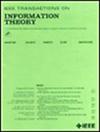Sequences With Identical Autocorrelation Functions
IF 2.2
3区 计算机科学
Q3 COMPUTER SCIENCE, INFORMATION SYSTEMS
引用次数: 0
Abstract
Aperiodic autocorrelation is an important indicator of performance of sequences used in communications, remote sensing, and scientific instrumentation. Knowing a sequence’s autocorrelation function, which reports the autocorrelation at every possible translation, is equivalent to knowing the magnitude of the sequence’s Fourier transform. The phase problem is the difficulty in resolving this lack of phase information. We say that two sequences are equicorrelational to mean that they have the same aperiodic autocorrelation function. Sequences used in technological applications often have restrictions on their terms: they are not arbitrary complex numbers, but come from a more restricted alphabet. For example, binary sequences involve terms equal to only +1 and −1. We investigate the necessary and sufficient conditions for two sequences to be equicorrelational, where we take their alphabet into consideration. There are trivial forms of equicorrelationality arising from modifications that predictably preserve the autocorrelation, for example, negating a binary sequence or reversing the order of its terms. By a search of binary sequences up to length 44, we find that nontrivial equicorrelationality among binary sequences does occur, but is rare. An integer n is said to be equivocal when there are binary sequences of length n that are nontrivially equicorrelational; otherwise n is unequivocal. For求助全文
约1分钟内获得全文
求助全文
来源期刊

IEEE Transactions on Information Theory
工程技术-工程:电子与电气
CiteScore
5.70
自引率
20.00%
发文量
514
审稿时长
12 months
期刊介绍:
The IEEE Transactions on Information Theory is a journal that publishes theoretical and experimental papers concerned with the transmission, processing, and utilization of information. The boundaries of acceptable subject matter are intentionally not sharply delimited. Rather, it is hoped that as the focus of research activity changes, a flexible policy will permit this Transactions to follow suit. Current appropriate topics are best reflected by recent Tables of Contents; they are summarized in the titles of editorial areas that appear on the inside front cover.
 求助内容:
求助内容: 应助结果提醒方式:
应助结果提醒方式:


